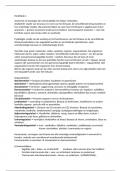DEV ECONOMIES:
Howell, 2006 or Besson, 2009: planned rationale, not market rationale; political elites dedicated to
economic growth/national stability; productivist welfarism (less focus on social goals - Holliday,
2000); strong state intervention, export orientation; politically repressive (freedom and rights) and
weak civil society.
Castells, 1992: Principle of legitimacy = ability to promote and sustain economic growth and
development
- National project to construct national identity too (nation building)
Secondary Circuit:
Lefebvre, 2003’s theory — primary circuit stops expanding, flows into ‘property’ (secondary circuit
of real estate), secondary circuit becomes principal source, ‘supplants… and becomes ‘essential’
—> Planetary urbanisation (Merrifield, 2013), intense commodification of space under speculation
(Goldman, 2011) that extracts rent
Speculation = neoliberal alibi for creative destruction (Weber, 2002)
Investment in built env = creation of whole physical landscape for production, consumption,
accumulation
East Asia: simultaneous thrust of both circuits (urbanisation and industrialisation reinforce one
another)
- Creation of SEZ, can overcome spatial fixes for primary circuit (market access), excess money
from primary goes into secondary
- China: Shin, 2014: high speed rail networks, airports, metro construction and commercial real
state projects to support industrial production
- Uneven dev helps capital exploit surplus labour = low costs (Pun and Chan, 2012)
- State supports by providing land, infra and labour (housing and services in peri-urban/rural
areas)
- Ordos Kangbashi (Sorace and Hurst, 2015): rampant speculation + phantom city built on
fiscal excess of primary circuit
- New Beichuan (Sorace and Hurst, 2015): after construction and speculative gains, investment
into new industrial cluster but not successful: low wages, bad conditions, bad market
advantages
Fainstein, 2001: Property development becomes an economic growth strategy
Shin, 2010: vertical accumulation achieved by acquisition of property-related revenues, strong dev
states and speculative home-ownership aspirations
- Property revenues allow city development and redevelopment (cycle)
- State-biz nexus, profit-oriented and entrepreneurialism —> investments
- Homeowners want to build assets (for profit), similar to developers’ interests
- Tang, 2008: desire to accumulate property leads to idea that redev is societal progress for
middle class
- Culture of property prevents denunciation of redev and displacements (Ley and Teo, 2013)
Vicious cycle of capital investment and reI + compressed cycle of property dev and redev —>
vertical accumulation
Jang-sup Shin, 2007: main urban accumulation strategy of East Asian states = investment in infra
and tech to improve quality of built env
Urban revolution from above — rural pop become urbanites because rural land converted for urban
use (Lin et al., 2015)
Sorace and Hurst, 2015
- Nominal change and ‘upgrade’ of administrative status, without improving material conditions
(qualitative)
- Town to city, county to municipality… (Ma, 2005)
Page 1 of 14
, - Quickens urbanisation and modernisation processes throughout the country — Bulag, 2002:
magic of the term ‘city’
- Can construct urban facade (without basic infra and economic functions) Harvey, 2003
- Zhu, 2011: large-scale construction neglects QoL and needs of residents
- Aesthetic spectacle (Ren, 2012), to make a city is to show a city, merely to show political
achievements and for GDP (Yuan, 2008)
- Build replicas of famous cities
New city construction is politically motivated to achieve ideological aspirations as a show of power/
wealth and political legitimacy
- Ideological commitment: urban growth as royal road to modernity and to showcase political
performance (Shin, 2014)
Phantom urbanisation = city facade without inhabitants nor function (form divorced from practices
and uses) (Zhu, 2011)
- Urbanisation of land > urbanisation of people (1.71x faster) (Harvey, 2013)
Cartier and Tomba, 2012: For China, process of aesthetic formation is more important than
economic, demographic or env repercussion
E.g. New Beichuan (double empty shell: fake facade with rural population)
- Rural dwellers had hard time adjusting to urban life (Xie, 2011)
- Centre of city lacks personality, resident and commercial district geographically separated
- Starkitecture, fibre optics
Urbanisation driven by local state to address political aspirations and legitimise their positions as
vanguards of new Chinese urbanism (urbanisation of local state — Hsing, 2010)
- No signs of stopping: local state apparatus grows along with urban expansion (Hsing, 2010)
- Dependence on land revenue, constant ABD of homes in high-value locations (residents offered
low compensation) (Lin, 2009)
Top-down planning and forced migration (Wenchuan earthquake: citizens forcefully relocated to An
County). Double facade: rural villagers in city with form but lack function and use.
According to the logic and dynamics of accumulation (Lin and Yi, 2011)
- Administrative border-drawing to expropriate of land and investment in expanding urban infra —
> profits — Kangbashi: invest receipts from primary sector into secondary circuit by building a
new city and infrastructure
- Make rural villagers become urban consumers —> Growth (Harvey, 2008)
Urbanisation of land and infrastructure > urbanisation of people (1.7x faster)
Ghost cities seen as a temporary problem
If we build people will come (state beliefs) (Li, 2009)
Ghost cities will become tomorrow’s thriving metropolitan areas
Percival and Waley, 2012 on Cambodia:
- Facilitative role through attracting private-sector investment (Shatkin, 2011), promotion of RUM
and decentralisation, real estate is one of four national economic priorities (Sen, 2008)
- Legal: planning laws to encourage large projects, deregulation of property markets (70% of
foreign ownership of property allowed), allow labour migration of foreign talent
- Economic incentives: open to capital from foreign banks, import tax exemptions
- Good foreign relations, political stability
Privately built satellite cities (mainly for middle class)
- Adhering to international interpretation of how global urbanism should look and function
(Shatkin, 2011)
Page 2 of 14





